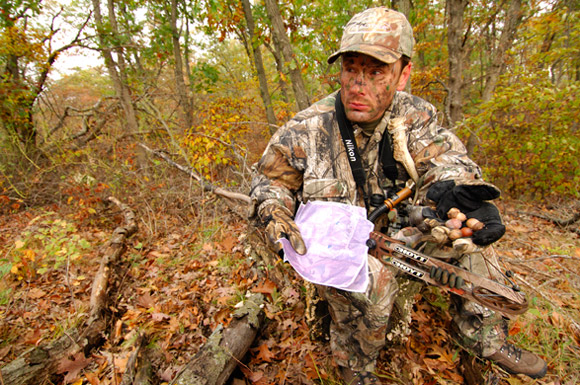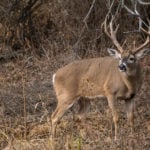LAST UPDATED: May 1st, 2015
During early season dates – September dates when bucks still wear velvet — my whitetail stands overlook water or obvious food sources, such as early-bearing oaks, alfalfa or clover, green soybeans, apple trees relinquishing the first fruit of the season or honeysuckle and green briars. When trail cameras reveal bucks are newly hard-horned I fall back into heavier vegetation nearer bedding cover in anticipation of growing nocturnal tendencies, hoping to catch bucks on the move at the very edges of legal shooting hours. With the rut approaching tactics again change completely.
Computer sites providing aerial photos of various terrains are great tools for finding hot rut-date stand sites.
Rut success is all about seeking funnels, ambush and “cutting them off at the pass.” Rutting bucks travel widely, wandering outside core comfort areas looking for that first hot estrous doe. Big bucks, as they say, “come out of the woodwork.” Food certainly becomes a center of attention once more, but only in the sense food attracts does and does attract rutting bucks. This is something rut-time bowhunters must continually bear in mind: where are the highest concentrations of does located and what route constitutes the path of least resistance between these pods of potential mates?
Now that I’ve tossed that out there, understand you can drive yourself batty over-analyzing the multitude of scenarios associated with even a moderate catalog of terrain types and hunt areas. Make it easier on yourself; concentrate on micro aspects of topography instead of making yourself crazy attempting to digest the big picture in one big bite. This can start by gaining an intimate familiarity with the land you hunt (during off season when disturbing deer has no immediate effects on hunting). On new acreage, or larger chunks of public land, poring over detailed U.S. Geographical Survey maps is the next best thing – and may be even more productive as they provide a bird’s-eye view in manageable scale. Such maps reveal the precise location of saddles, ridge points and spines, hanging benches and draw heads that automatically concentrate game movement. The modern whitetail hunter can also employ aerial maps on sites such as http://www.usgs.gov/pubprod, http://www.terraserver.com or www.globeexplorer.com. These sites give you instant insight into vegetation factors influencing deer movement. Based on this newfound information, here are some places to concentrate efforts on.
Inside Corners
Field corners concentrate deer movement on two fronts; on the outside by creating an intersection for bucks cruising field edges, and the inside, providing a pinch point for bucks wary of open spaces and staying under the cover of the tree-line. You’ll regularly notice, especially on lightly-hunted ground, scrapes and rubs most often appear on field edges or fence-lines. Bucks travel field edges because it allows covering ground fast, seeing potential mates across open space, as often providing a path of least resistance between various pieces of habitat. During the rut field edges are always a good bet; corners concentrating movement because they constitute the intersection of two edges.
Field corners funnel deer from the inside and out, creating an edge intersection on the inside, a deflection point on the outside.
On properties where deer are subjected to more hunting pressure, bucks often choose to travel on the inside edge of field-edge cover, avoiding open areas where they feel more vulnerable. Setting up on the threshold of open field and woodlands allows shooting at bucks inside and out of that edge. Bucks avoiding open ground regularly skirt open fields. Corners naturally act as a converging point for trails vectoring in from many points of the compass, compressing at the corner while seeking the most efficient path between Points A and B while circumventing such “obstacles.” Field corners are always hot rut-time stand sites.
Water Deflections
Just as open fields concentrate deer at its corners, large or small bodies of water – river bends, beaver ponds, large stock tanks or farm ponds – often funnel deer in the same manner. Deer actually swim quite well, but generally like to keep their feet dry when given the option. One note of caution, though. Because water continually seeks the lowest level in any terrain, water means bottoms. Bottoms generally make poor stand sites because eddying breezes and scent traps quickly give you away. The best water deflection sites are those where prevailing winds reliably flow off higher ground and safely across open water where it cannot reach a deer’s nose. Look at an average beaver pond, just for instance, and you’ll generally find a well-worn trail at one of its corners, revealing concentrated movement.
Water corner, like field corners, often act as a prime funneling points to place rut-season stands.
Ditch Heads & Crossings
It’s the rare whitetail habitat that isn’t filled with deep erosion cuts, ditches or steep-walled creek or river beds. The very best, in terms of funneling deer past deer stands, are those found between agricultural fields, separating one piece of prime habitat from another or running through the middle of limited woodlands escape cover. These deep, steep-walled terrain features act as real travel barriers. Take the time to walk these ditches and creek-beds out while scouting and you’ll soon find a start to the erosion creating the ditch (sometimes a flat bottom dropping suddenly into a cut full of rocks or tree slash in an attempt to control that attrition), or in the case of creeks, obvious trails cutting across the waterway or a gentle spot where trails converge. These sites are real hotspots for concentrating rutting-buck movement because deer have little choice but to skirt such obstacles while cruising between swatches of habitat.
Fence Breaks
Obviously healthy deer can jump any standard-issue woven- or barb-wire fence dicing up the typical farm or ranch. But unmolested whitetails are essentially lazy, or at least choose to conserve energy whenever possible. Let a dead tree fall across a fence-line, creating an open gap, and deer will walk 100 yards out of their ways to use that gap. A gate left open at a field corner is more likely to funnel movement than 300 yards of tight fence wire.
Deer are basically lazy, the point of least resistance – like this fence break – invariable preferred while traveling.
Topography Funnels
In rougher whitetail habitat, those hilly or even mountainous areas whitetail often thrive in, look to obvious terrain features such as saddles and ridge points that create natural travel-ways. This really needs little explanation, creating the perfect illustration of the path of least resistance. Why cross a high ridge when you can angle into a saddle and save 500 feet of climbing? Why fight the brush of a tangled bottom when you can walk a relatively open ridge crest?
Topographical maps from the U.S. Geological Survey provide detailed, bird’s-eye views of terrain to help make stand placement easier.
Ridge Highways & Hanging Benches
Remember, too, cruising bucks looking for rut-time action attempt to make their searches as efficient as possible while working through a given swatch of territory. One of the ways they do this is by walking ridge tops, canyon edges and hanging benches (including defunct logging roads). These features not only provide easier passage, but allow maximum efficiently in their search for does. Walking ridge crests gives them visual and olfactory reach to both sides of the ridge. Walking canyon edges or benches allows scent-checking uphill while visually watching downhill.
Ridges are always used by deer while traveling because they are more easily traversed than tangled bottoms.
All of that said the very best tree-stand sites for rut action, the real killing trees, normally involve a combination of many of these factors – the field corner pointing directly into a ridge point just above a ditch head at an open gate. Just as an example of one of my favorite Kansas stands… While bowhunting rutting bucks keeping topography in mind invariably results in seeing more deer.

 By
By 




